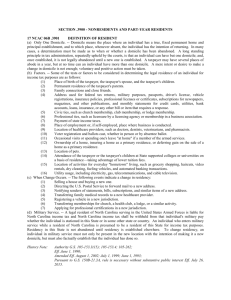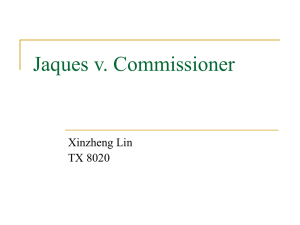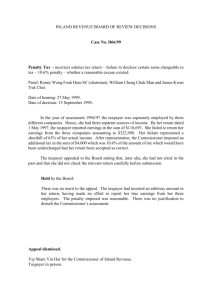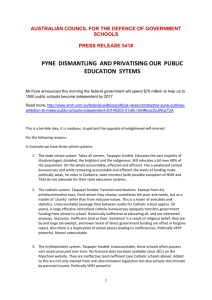Uniform Division of Income for Tax Purposes Act
advertisement
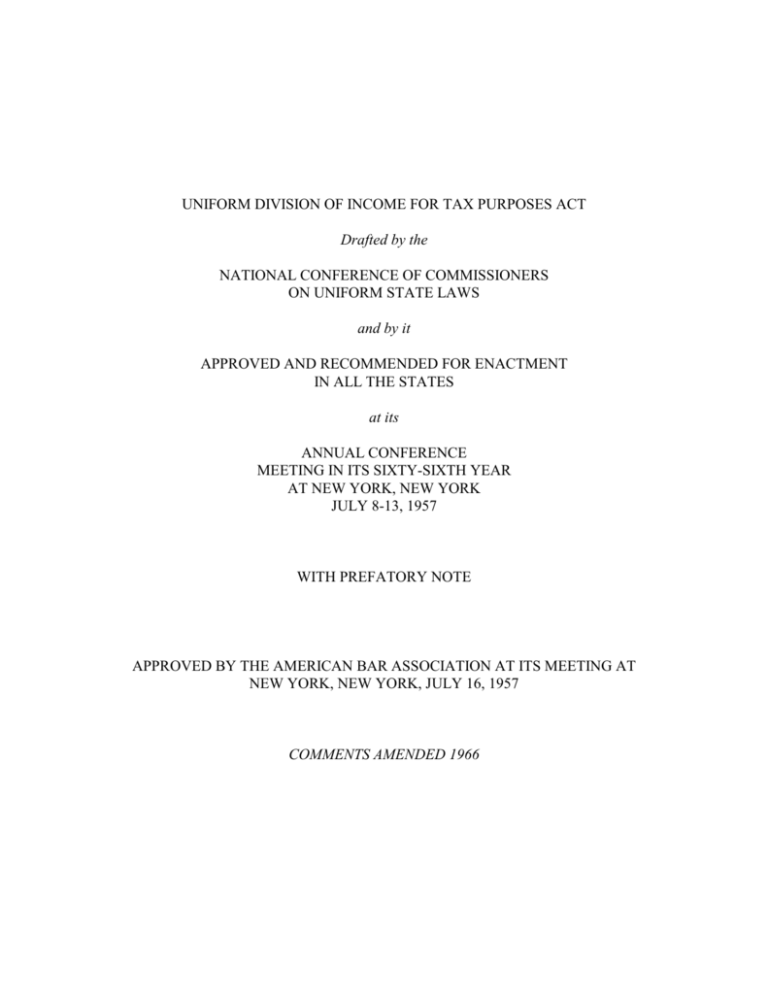
UNIFORM DIVISION OF INCOME FOR TAX PURPOSES ACT Drafted by the NATIONAL CONFERENCE OF COMMISSIONERS ON UNIFORM STATE LAWS and by it APPROVED AND RECOMMENDED FOR ENACTMENT IN ALL THE STATES at its ANNUAL CONFERENCE MEETING IN ITS SIXTY-SIXTH YEAR AT NEW YORK, NEW YORK JULY 8-13, 1957 WITH PREFATORY NOTE APPROVED BY THE AMERICAN BAR ASSOCIATION AT ITS MEETING AT NEW YORK, NEW YORK, JULY 16, 1957 COMMENTS AMENDED 1966 The Committee which acted for the National Conference of Commissioners on Uniform State Laws in preparing the Uniform Division of Income for Tax Purposes Act was as follows: George V. Powell, 1111 Dexter Horton Bldg., Seattle 4, Wash., Chairman Guy W. Botts, Barnett National Bank Bldg., Jacksonville, Fla. Rupert R. Bullivant, Pacific Bldg., Portland, Ore. Barton H. Kuhns, First National Bank Bldg., Omaha 2, Nebr. Jo. V. Morgan, District of Columbia Tax Court, 4th & E Sts., N.W., Washington 1, D.C. O.H. Thormodsgard, University of North Dakota Law School, University, N.D., Chairman, Section C Copies of all Uniform Acts and other printed matter issued by the Conference may be obtained from: NATIONAL CONFERENCE OF COMMISSIONERS ON UNIFORM STATE LAWS 1155 East Sixtieth Street Chicago 37, Illinois UNIFORM DIVISION OF INCOME FOR TAX PURPOSES ACT PREFATORY NOTE The Uniform Division of Income for Tax Purposes Act is designed for enactment in those states which levy taxes on or measured by net income. The need for a uniform method of division of income for tax purposes among the several taxing jurisdictions has been recognized for many years and has long been recommended by the Council of State Governments. There is no other practical means of assuring that a tax-payer is not taxed on more than its net income. At present, the several states have various forumlae for determining the amount of income to be taxed, and the differences in the formulae produce inequitable results. The problem has been well analyzed and its historical background outlined in an article appearing in 18 Ohio State Law Journal, page 84. The Uniform Division of Income for Tax Purposes Act is the result of conferences with the representatives of the Controller’s Institute of America, the Council of State Governments and various interested individuals. -3- UNIFORM DIVISION OF INCOME FOR TAX FOR TAX PURPOSES ACT Section 1. As used in this Act, unless the context otherwise requires: (a) “Business income” means income arising from transactions and activity in the regular course of the taxpayer’s trade or business and includes income from tangible and intangible property if the acquisition, management, and disposition of the property constitute integral parts of the taxpayer’s regular trade or business operations. Comment This definition refers to the taxpayer’s trade or business as if he had one business. It is not intended by this language to require a taxpayer having several “businesses” to use the same allocation and apportionment methods for the businesses. The language permits separate treatment of different businesses of a single taxpayer. Section 18 clearly permits separate treatment. Income from the disposition of property used in a trade or business of the taxpayer is includible within the meaning of business income. (b) “Commercial domicile” means the principal place from which the trade or business of the taxpayer is directed or managed. Comment The phrase “directed or managed” is not intended to permit both the state where the board of directors meets and the state where the company is managed to claim the commercial domicile. The phrase “directed or managed” is intended as two words serving the same end; not as two separate concepts. (c) “Compensation” means wages, salaries, commissions and any other form of remuneration paid to employees for personal services. Comment This definition is derived from the Model Unemployment Compensation Act which has been adopted in all states. Compensation paid to “employees” becomes important in the payroll fraction in Section 13. If a corporation is employed to provide personal services, Section 18 may be used to include -4- compensation paid to corporations in the fraction if exclusion of compensation paid to corporate agents fails to reflect adequately the business activity in the state. (d) “Financial organization” means any bank, trust company, savings bank, [industrial bank, land bank, safe deposit company], private banker, savings and loan association, credit union, [co-operative bank], investment company, or any type of insurance company. Comment This definition and the definition of “public utility” in Subsection (f) is necessary because Section 2 excludes from allocation and apportionment under this Act, income from these two types of business activity. The exclusion is proposed because some states have separate legislation for apportionment and allocation of income of such taxpayers. If not, and the state proposes to change Subsection (2) so as to apply the Act to such taxpayers, this would not necessarily detract from the uniformity objective of this Act. (e) “Non-business income” means all income other than business income. (f) “Public utility” means [any business entity which owns or operates for public use any plant, equipment, property, franchise, or license for the transmission of communications, transportation of goods or persons, or the production, storage, transmission, sale, delivery, or furnishing of electricity, water, steam, oil, oil products or gas.] Comment It is expected that “public utility” will be defined to include all taxpayers subject to the control of the state’s regulatory bodies on the theory that separate legislation will provide for the apportionment and allocation of the income of such taxpayers. See Comment to the definition of “financial organization” for purpose of this definition. “Oil, oil products or gas” is not intended to be so restrictive as to treat differently a public utility, if any, which transmits or produces “gas products.” The essential point of the definition is the requirement that the business excluded by this definition and Subsection 2 be a “public utility.” Private transmission lines and private production or storage companies are thus not excluded. (g) “Sales” means all gross receipts of the taxpayer not allocated under Sections 4 through 8 of this Act. Comment -5- This all inclusive definition of sales is intended to make apportionable all income not allocated under Sections 4 though 8. As indicated in the Comment to Subsection (1)(a) income from sales of property used in trade or business is included in apportionable income. (h) “State” means any state of the United States, the District of Columbia, the Commonwealth of Puerto Rico, any territory or possession of the United States, and any foreign country or political subdivision thereof. Section 2. Any taxpayer having income from business activity which is taxable both within and without this state, other than activity as a financial organization or public utility or the rendering of purely personal services by an individual, shall allocate and apportion his net income as provided in this Act. Section 3. For purposes of allocation and apportionment of income under this Act, a taxpayer is taxable in another state if (1) in that state he is subject to a net income tax, a franchise tax measured by net income, a franchise tax for the privilege of doing business, or a corporate stock tax, or (2) that state has jurisdiction to subject the taxpayer to a net income tax regardless of whether, in fact, the state does or does not. Comment This Section defines, for purposes of Section 2, where a taxpayer is “taxable both within and without this state.” To bring this Act into operation a taxpayer must have income from business activity, and he must be taxable in this state, and also in some other state. Two tests are used by this Section to determine when a taxpayer is “taxable in another state.” The first test is a fairly obvious one, the taxpayer is taxable in another state if he is actually subjected to the type of taxes listed in Subparagraph (1). The second test, in Subparagraph (2) uses a “notional” or “hypothetical” standard rather than an actual one. Thus, if a corporation has its commercial domicile in state X, which has only a sales tax and no tax measured by net income, but that corporation has business activity in state A, which has this apportionment Act, state A must apportion the business income as provided in this Act so that some of it is allocated to state X, even though as a result of the tax system of state X a portion of the business income escapes income taxation. This is desirable in order to treat the business of all states equally, and in order to avoid having this Act as a factor in inducing a -6- state to have an income tax. If it does not wish to tax income, that is no reason for a state which does wish to tax income to attempt to obtain more than its share of taxable income. It should be noted that in Subsection (1)(h) the word “state” is defined broadly enough to include a foreign country. This means that “taxable in another state” within Section 3 may mean a foreign country. The apportioning state, however, need consider only whether the foreign country “could have” taxed the income under the constitution of the United States if it had been a state. While Subparagraph (1) lists several types of taxes which might be actually in effect in another state, the reference in Subparagraph (2) only to a “net income” tax is not intended to be more restricted in the hypothetical tax than the Section is with respect to an actual tax. Section 4. Rents and royalties from real or tangible personal property, capital gains, interest, dividends, or patent or copyright royalties, to the extent that they constitute non-business income, shall be allocated as provided in sections 5 through 8 of this act. Comment This Section is the general Section on “allocating” nonbusiness income to a state just as Section 9 is the general Section on apportionment of business income. Section 2 refers to an allocation and an apportionment of “net income.” In “allocating” nonbusiness income to a state, the states concerned with this allocation may desire to allocate the expenses properly attributable to nonbusiness but allocable income in the same way that income is allocated so that these expenses will not be involved in determining net income from business activity where apportionment is used. Section 18 of this Code empowers the state to make this adjustment if it wishes. Section 5. (a) Net rents and royalties from real property located in this state are allocable to this state. (b) Net rents and royalties from tangible personal property are allocable to this state: (1) if and to the extent that the property is utilized in this state, or (2) in their entirety if the taxpayer’s commercial domicile is in this state and the taxpayer is not organized under the laws of or taxable in the state in which the property is utilized. (c) The extent of utilization of tangible personal property in a state is determined by -7- multiplying the rents and royalties by a faction, the numeratory of which is the number of days of physical location of the property in the state during the rental or royalty period in the taxable year and the denominator of which is the number of days of physical location of the property everywhere during all rental or royalty periods in the taxable year. If the physical location of the property during the rental or royalty period is unknown or unascertainable by the taxpayer tangible personal property is utilized in the state in which the property was located at the time the rental or royalty payer obtained possession. Comment Rents from mobile tangible property are to be allocated in accordance with Section 5(c). This Subsection apportions the rents by a fraction based on the number of days in the state on the assumption that the rents are generally based on time of use. If the rent itself is calculated on the basis of some factor other than time, Section 18 would permit a state to substitute a fraction based on this substitute factor. Thus, if the rent for a drilling rig is calculated on the basis of number of feet drilled, the “extent of utilization” in the state might also be determined on the basis of a fraction which uses “feet drilled” rather than days in the state. Section 6. (a) Capital gains and losses from sales of real property located in this state are allocable to this state. (b) Capital gains and losses from sales of tangible personal property are allocable to this state if (1) the property had a situs in this state at the time of the sale, or (2) the taxpayer’s commercial domicile is in this state and the taxpayer is not taxable in the state in which the property had a situs. (c) Capital gains and losses from sales of intangible personal property are allocable to this state if the taxpayer’s commercial domicile is in this state. Section 7. Interest and dividends are allocable to this state if the taxpayer’s commercial -8- domicile is in this state. Section 8. (a) Patent and copyright royalties are allocable to this state: (1) if and to the extent that the patent or copyright is utilized by the payer in this state, or (2) if and to the extent that the patent or copyright is utilized by the payer in a state in which the taxpayer is not taxable and the taxpayer’s commercial domicile is in this state. (b) A patent is utilized in a state to the extent that it is employed in production, fabrication, manufacturing, or other processing in the state or to the extent that a patented product is produced in this state. If the basis of receipts from patent royalties does not permit allocation to states or if the accounting procedures do not reflect states of utilization, the patent is utilized in the state in which the taxpayer’s commercial domicile is located. (c) A copyright is utilized in a state to the extent that printing or other publication originates in the state. If the basis of receipts from copyright royalties does not permit allocation to states or if the accounting procedures do not reflect states of utilization, the copyright is utilized in the state in which the taxpayer’s commercial domicile is located. Section 9. All business income shall be apportioned to this state by multiplying the income by a faction, the numerator of which is the property factor plus the payroll factor plus the sales factor, and the denominator of which is three. Section 10. The property factor is a fraction, the numerator of which is the average value of the taxpayer’s real and tangible personal property owned or rented and used in this state during the tax period and the denominator of which is the average value of all the taxpayer’s real and tangible personal property owned or rented and used during the tax period. -9- Comment The property is to be included in the numerator and denominator is property producing the net income to be apportioned. If net income from property is allocated property under Section 5 through Section 8, such property should be excluded in constructing the fraction. Section 11. Property owned by the taxpayer is valued at its original cost. Property rented by the taxpayer is valued at eight times the net annual rental rate. Net annual rental rate is the annual rental rate paid by the taxpayer less any annual rental rate received by the taxpayer from sub-rentals. Comment This section is admittedly arbitrary in using original cost rather than depreciated cost, and in valuing rented property as eight times the annual rental. This approach is justified because the act does not impose a tax, nor prescribe the depreciation allowable in computing the tax, but merely provides a basis for division of the taxable income among the several states. The use of original cost obviates any differences due to varying methods of depreciation, and has the advantage that the basic figure is readily ascertainable from the taxpayer’s books. No method of valuing the property would probably be universally acceptable. In any situation where it is impossible to ascertain original cost, Section 18 may be used to determine a fair value for such property. Section 18 may also be necessary to aid in determining “net annual rental value” of tangible personal property where the actual rent is so related to services that the part attributable to the object is difficult to determine. Section 18 may also be used to determine a reasonable rental rate for this fraction where the actual rent is zero or nominal such as may be the case where a local government in attempting to induce an industry to come to a community supplies the property at a nominal rental. Section 12. The average value of property shall be determined by averaging the values at the beginning and ending of the tax period but the [tax administrator] may require the averaging of monthly values during the tax period if reasonably required to reflect properly the average value of the taxpayer’s property. Section 13. The payroll factor is a fraction, the numerator of which is the total amount paid in this state during the tax period by the taxpayer for compensation, and the denominator of -10- which is the total compensation paid everywhere during the tax period. Comment Payroll attributable to management or maintenance or otherwise allocable to nonbusiness property should be excluded from the fraction. Payroll “paid” should be determined by the normal accounting methods of the business so that if the taxpayer “accrues” such matters the payroll should be treated as “paid” for purpose of this Section. Section 14. Compensation is paid in this state if: (a) the individual’s service is performed entirely within the state; or (b) the individual’s service is performed both within and without the state, but the service performed without the state is incidental to the individual’s service within the state; or (c) some of the service is performed in the state and (1) the base of operations or, if there is no base of operations, the place from which the service is directed or controlled is in the state, or (2) the base of operations or the place from which the service is directed or controlled is not in any state in which some part of the service is performed, but the individual’s residence is in this state. Comment This section is derived from the Model Unemployment Compensation Act. This is the same figure which will be used by taxpayers for unemployment compensation purposes. Section 15. The sales factor is a fraction, the numerator of which is the total sales of the taxpayer in this state during the tax period, and the denominator of which is the total sales of the taxpayer everywhere during the tax period. Comment The sales to be included in the fraction are only the sales which produce business income. Sales which produce “capital gains” are under Section 6 and are to be allocated rather than -11- apportioned. “Total sales” means “total net sales” after discounts and returns. Section 16. Sales of tangible personal property are in this state if: (a) the property is delivered or shipped to a purchaser, other than the United States government, within this state regardless of the f.o.b. point or other conditions of the sale; or (b) the property is shipped from an office, store, warehouse, factory, or other place of storage in this state and (1) the purchaser is the United States government or (2) the taxpayer is not taxable in the state of the purchaser. Comment Sales to the United States Government are treated separately because they are not necessarily attributable to a market existing in the state to which the goods are originally shipped. The phrase “delivered or shipped to a purchaser” in this state includes shipments, at the designation of the purchaser, to a person in this state such as designating, while a shipment is en route, the ultimate recipient. Sales to the United States are treated separately. It is thought that this is justified because sales to the United States are not necessarily attributable to a market existing in the state to which the goods are originally shipped. This different treatment may also be justified because, if the goods are defense or war materials, it may be impossible to determine whether the goods ever came to rest in the state due to use of coded delivery instructions. The Section does not specify how sales from a subsidiary in the state to an out-of-state parent, such as a marketing corporation who thereupon redirects the goods back into the state, should be treated. If returns are not consolidated under existing state tax law, it may be necessary to use Section 18 to make a fair representation of the business income in this situation. Section 17. Sales, other than sales of tangible personal property, are in this state if: (a) the income-producing activity is performed in this state; or (b) the income-producing activity is performed both in and outside this state and a greater proportion of the income-producing activity is performed in this state than in any other state, based on costs of performance. Section 18. If the allocation and apportionment provisions of this Act do not fairly -12- represent the extent of the taxpayer’s business activity in this state, the taxpayer may petition for or the [tax administrator] may require, in respect to all or any part of the taxpayer’s business activity, if reasonable: (a) separate accounting; (b) the exclusion of any one or more of the factors; (c) the inclusion of one or more additional factors which will fairly represent the taxpayer’s business activity in this state; or (d) the employment of any other method to effectuate an equitable allocation and apportionment of the taxpayer’s income. Comment It is anticipated that this act will be made a part of the income tax acts of the several states. For that reason, this section does not spell out the procedure to be followed in the event of a disagreement between the taxpayer and the tax administrator. The income tax acts of each state presumably outline the procedure to be followed. Section 18 is intended as a broad authority, within the principle of apportioning business income fairly among the states which have contact with the income, to the tax administrator to vary the apportionment formula and to vary the system of allocation where the provisions of the Act do not fairly represent the extent of the taxpayer’s business activity in the state. The phrases in Section 18(d) do not foreclose the use of one method for some business activity and a different method for a different business activity. Neither does the phrase “method” limit the administrator to substituting factors in the formula. The phrase means any other method of fairly representing the extent of the taxpayer’s business activity in the state. Section 19. This Act shall be so construed as to effectuate its general purpose to make uniform the law of those states which enact it. Section 20. This Act may be cited as the Uniform Division of Income for Tax Purposes Act. Section 21. [The following acts and parts of acts are hereby repealed: -13- (a) (b) (c) .] Section 22. This Act shall take effect ............................................................. -14-



